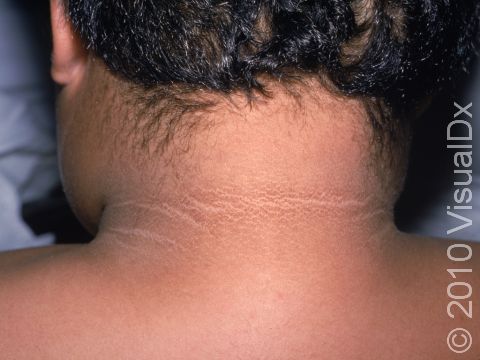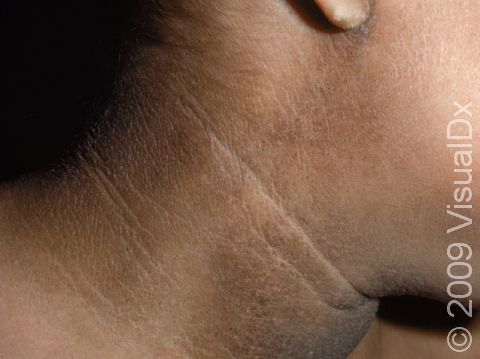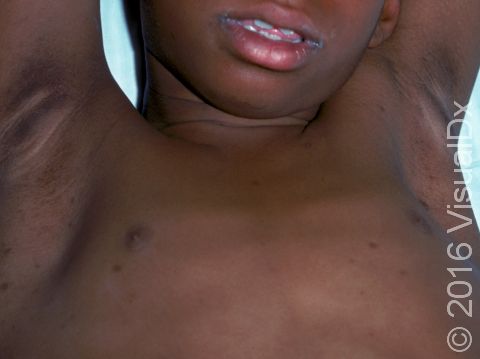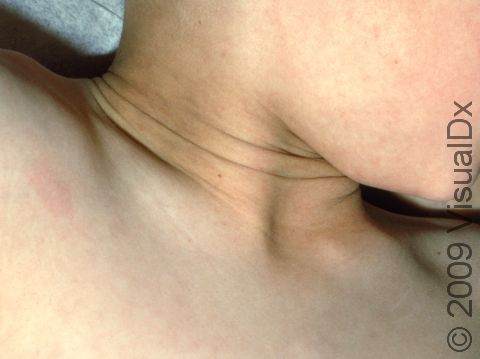Acanthosis Nigricans
Acanthosis nigricans is a skin condition of thickening and darkening of the skin, especially in body creases such as the underarms, groin, and neck. Its cause is unknown, but it may be associated with obesity, although it can occasionally be found in people who have more serious health problems or who are taking certain medications, or in some cases it may be hereditary. Treatment of any underlying medical condition, if present, usually cures the skin lesions.
Who's At Risk?
Acanthosis nigricans can affect individuals of any age and of any racial / ethnic background. It can develop in children and in teenagers, but it is most common in adults. Males and females are affected equally.
Acanthosis nigricans most commonly develops in:
- People who are overweight or obese.
- People with diabetes or other glandular (endocrine) problems.
- People taking certain medications (such as oral contraceptives, niacinamide, or corticosteroids).
- People who have had a kidney transplant.
If acanthosis nigricans develops from an internal malignancy, weight loss and other related symptoms may be present.
Signs & Symptoms
The lesions of acanthosis nigricans appear as “velvety,” thickened plaques (slightly raised areas that are larger than a thumbnail). They can range in color from gray to brown to black, and they are often darkest in individuals with darker skin colors. The affected areas may also develop skin tags (acrochordons). The affected areas may be itchy.
The most common locations for acanthosis nigricans include the:
- Sides and back of the neck.
- Underarms.
- Groin.
Less commonly, acanthosis nigricans can affect the:
- Face.
- Inner thighs.
- Elbows.
- Knees.
- Belly button.
Rarely, acanthosis nigricans can occur in the:
- Nipples.
- Eyelids.
- Lips.
- Inside of the mouth.
- Anus.
Self-Care Guidelines
In those who are overweight, losing the extra weight can dramatically improve the appearance of the acanthosis nigricans or potentially completely cure it.
Over-the-counter treatments to consider are:
- Preparations containing alpha hydroxy acids such as glycolic acid or lactic acid (eg, AmLactin Daily Moisturizing Therapy).
- Lotions containing the beta hydroxy acid salicylic acid (eg, CeraVe SA Cream).
- Creams containing urea (eg, Ureacin-20 Moisturizing Cream).
- Cortisone cream if the areas are itchy.
Treatments
The child’s medical professional will want to first establish the cause of the acanthosis nigricans. If it is due to obesity, they can help you find healthy ways for your child to lose weight. If obesity is not a factor, the medical professional may order blood tests or other types of tests to find the cause. If the acanthosis nigricans is caused by a medication, the medical professional may be able to prescribe a substitute medication.
Once any medical condition has been established and treatment has been started, the medical professional may recommend a topical cream or lotion for the acanthosis nigricans containing:
- Alpha or beta hydroxy acids (glycolic acid, lactic acid, salicylic acid) or urea.
- A retinoid such as tretinoin, tazarotene, or adapalene with or without ammonium lactate lotion or cream.
For more severe, stubborn acanthosis nigricans, treatments that may be recommended include:
- Isotretinoin.
- Laser treatments (which make the skin thinner by destroying the uppermost layers).
- Trichloroacetic acid peels.
Visit Urgency
See your child’s medical professional if the child develops thickening and darkening of the skin folds. If the acanthosis nigricans is due to obesity, the medical professional can help you find healthy ways for your child to lose weight.
If your child develops sudden or widespread acanthosis nigricans (affecting the skin folds as well as the palms of the hands, the lips, and other areas) or if your child has acanthosis nigricans and is losing weight without trying, see their medical professional promptly to make sure there is no underlying serious medical condition, such as malignancy.
References
Bolognia J, Schaffer JV, Cerroni L. Dermatology. 4th ed. Philadelphia, PA: Elsevier; 2018.
James WD, Elston D, Treat JR, Rosenbach MA. Andrew’s Diseases of the Skin. 13th ed. Philadelphia, PA: Elsevier; 2019.
Kang S, Amagai M, Bruckner AL, et al. Fitzpatrick’s Dermatology. 9th ed. New York, NY: McGraw-Hill Education; 2019.
Paller A, Mancini A. Paller and Mancini: Hurwitz Clinical Pediatric Dermatology. 6th ed. St. Louis, MO: Elsevier; 2022.
Last modified on July 13th, 2023 at 6:15 pm

Not sure what to look for?
Try our new Rash and Skin Condition Finder





